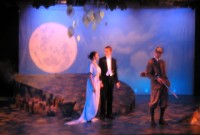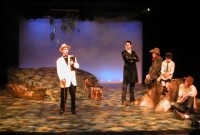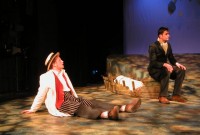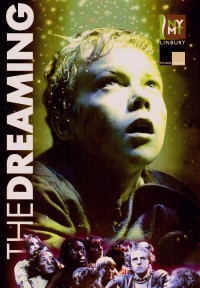Links to Shakespeare 4
A MIDSUMMER NIGHT’S DREAM IN PERFORMANCE
By Prof Stanley Wells, chairman of the Shakespeare Birthplace Trust, Stratford-upon-Avon
There’s a lot we don’t know about how A Midsummer Night’s Dream was performed in Shakespeare’s theatre. Was it actually written for an aristocratic wedding as many have argued? Were the fairies played by children brought in for the occasion, or by the boy actors regularly employed by the company, or by grown men (as in Peter Brook’s production)? Were Oberon and Theseus, Titania and Hippolyta doubled (as also by Brook), and if so, was the audience expected to see any significance in the doubling? Was any attempt made to represent the wood nearAthens, or was the audience left to use its imagination? Imagination is a key word of the play; the play acted within the play strains the imaginative capacities of both those who perform it and those who watch it on stage; and the unrealities of a plot that reaches a climax in an encounter between the Queen of the Fairies and a weaver transformed into an ass demands the imaginative participation of its theatrical audience too. Only imagination can find concord in this discord, and over the centuries the theatre has not always met the imaginative challenges that the play poses. It has been distorted especially by over-emphasis of both its broad comedy and the opportunitites it offers for stage spectacle.
As early as 1661 appeared a playlet called The Merry Conceited Humours of Bottom the Weaver, reducing the play to little more than the rehearsal and performance of Pyramus and Thisbe, and in an adaption of As You Like It by Charles Johnson in 1723, Love in a Forest, the Pyramus and Thisbe episodes were incorporated as an entertainment for the banished Duke and his followers. America has seen a version called Swingin’ the Dream (1939), in which the Bottom who roared as gently as any sucking-dove was Louis Armstrong. The mechnicals’ scenes, parodies of the efforts of amateur entertainers, have themselves formed the centrepiece of many amateur entertainments in later ages, a constant source of innocent mirth in school halls and village institutes. Exploitation of the play’s opportunities for spectacle also has a long histroy. When Samuel Pepys saw it in 1662 only its incidental features appealed to him. He wrote: “We saw aMidsummer Night’s Dream, which I have never seen before nor shall ever again, for it is the most insipid ridiculous play that ever I saw in my life. I saw, I confess, some good dancing, and some handsome women, which was all my pleasure.”
Thirty years later appeared The Fairy Queen a lavish spectacle with a marvellous score by Henry Purcell; though this is based on Shakespeare, Purcell set no line of the play. Another musical version is Frederick Reynolds’s (with music by Henry Bishop) of 1816, which provoked a violent attack by William Hazlitt: “All that’s fine in the play, was lost in the representation. The spirit was evaporated, the genius was fled; but the spectacle was fine: it was that which saved the play. Oh, ye scene-shifters, ye scene-painters, ye machinists and dressmakers, ye manufacturers of moon and stars that give no light, ye musical composers, ye men in the orchestra, fiddlers and trumpeters and players on the double drum and loud bassoon, rejoice! This is your triumph; it is not ours.” Hazlitt depressingly concluded that “Poetry and the stage do not agree together.”
The play was last produced in something like its original form by Elizabeth Vestris at Covent Garden in 1840, but the nineteenth-century production outstanding for excellence of both acting and staging was Samuel Phelps’s at Sadler’s Wells in 1853; dream-like visual effects created by gaslight and gauzes were praised, but it is clear too that they were fully at the service of the play. Later productions have not always been so successful in subordinating spectacle to drama. Shaw wrote of Augustin Daly’s in 1895: “He certainly has no suspicion of the fact that every accessory he employs is brought in at the deadliest risk of destroying the magic spell woven by the poet. He swings Puck away on a clumsy trapeze with a ridiculous clash of the cymbals in the orchestra, in the fullest belief that he is thereby completing instead of destroying the effect of Puck’s lines. His panoramic illusion of the passage of Theseus’s barge toAthensis more absurd than anything that occurs in the tragedy of Pyramus and Thisbe in the last act.” The pictorial, quasi-operatic style of production, in which presentation of the fairy world was assimilated to the traditions of classical ballet, continued well into this century, influencing for instance Max Reinhardt’s film of 1935 and the BBC television version, and has still not been entirely abandoned. But Harley Granville Barker’s Savoy Theatre production of 1914 presented a thorough re-thinking of the play which effected a healthy if temporary clearance of conventional accretions. Mendelssohn’s exquisite music, completed in 1843 for a German performance, was abondoned in favour of English folk tunes, and Robin Goodfellow (or Puck) and Oberon were no longer played by women, as had been customary.
Granvile Barker broke the Victorian mould but did not establish a new one; since his time productions have drawn on a wide range of traditions, a few returning to the play’s origins, others rethinking its text in terms of contemporary theatre, and many mingling the Victorian with later methods. Critical writings have exerted their influence: Wilson Knight was followed by Jan Kott in drawing attention to the fairies’ sinister aspects (already apparent in nineteenth century artists’ representations), but Peter Brook, in his famous RSC production of 1970 followed Kott rather in emphasising Bottom’s sexuality than in adopting Kott’s vision of the fairy world as an existentialist nightmare. Brook set the play in a white box (as Granville Barker had recommended); costumes were timeless – loose satin garments in bright colours; we were reminded of the circus as Puck and Oberon swung on trapezes and Titania, seated on a great scarlet feather, descended from on high. For a while, the doubling of Oberon and Theseus, Titania and Hippolyta, adopted (though not initiated) by Brook, seemed to have established a pattern, yet it was abandoned by Bill Bryden in his National Theatre production of 1982, set in the early years of this century, whose “great concern, and great excitement”, wrote Robert Cuchman, was “to bring the play’s levels together, and yet keep them tantalisingly apart…. Oberon and Titania come face to face with Theseus and Hippolyta: a more powerful moment than can be produced by the now orthodox doubling of roles.”
Directors of the play frequently allude to its theatre history; at Stratford in 1981 Ron Daniels had set parts of it backstage in a Victorian theatre, and in 1989 John Caird’s determinedly, and exuberantly, post-modern production constantly alluded, often mockingly, sometimes parodistically, to the play’s performance histroy in, for instance, its use of Mendelssohn’s overture which began authentically but took on rock rhythms as it progressed, in the portrayal of the fairy attendants as horrible teenagers, the girls with wings and tutus reminiscent of Swan Lake, and in a Puck with a habit of mimicking everyone within sight or mind and who at one point read his lines from a printed copy of the play (my own New Penguin edition, as it happened), which he then threw derisively aside, sometimes hitting one of the bandsman. The 2200 or so lines of verse and prose that Shakespeare wrote in the mid 1590s have been astonishingly productive of music, operas, ballets, paintings, and other writings as well as of an immensely varied range of performances of the text either in adaption or as written; the play is different each time we see it, a constant stimulus to the imaginations of performers and audiences alike.
(this essay was published in the programme for a 1998 Oxford Stage Company production of Shakespeare’s play, directed by John Retallack)



